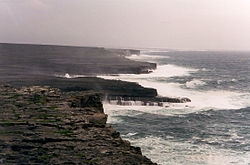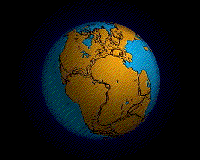Atlantic Ocean

The Atlantic Ocean is the second-largest of the world's oceans. It lies to the west of the British Isles and reaches southward to the Falkland Islands and the Southern Ocean. With a total area of about 41,000,000 square miles,[1] the Atlantic Ocean covers approximately 20% of the Earth's surface and about 26% of its water surface area.
The Atlantic Ocean occupies an elongated, S-shaped basin extending longitudinally between Britain, Europe and Africa to the east, and the Americas to the west. As one component of the interconnected global ocean, it is connected in the north to the Arctic Ocean, to the Pacific Ocean in the southwest, the Indian Ocean in the southeast, and the Southern Ocean in the south. The equator divides it into the North Atlantic Ocean and South Atlantic Ocean.
Name
The oldest known mention of "Atlantic" is in The Histories of Herodotus around 450 BC (Hdt. 1.202.4): Atlantis thalassa (Greek: Ἀτλαντὶς θάλασσα) or "Sea of Atlas", a name shared with the Atlas Mountains in North Africa. The term "Ethiopic Ocean", derived from Ethiopia, was applied to the southern Atlantic Ocean as late as the mid-19th century.[2] Before Europeans discovered other oceans, the term "ocean" itself was the term for the waters beyond the Strait of Gibraltar that we now know as the Atlantic. The early Greeks believed this ocean to be a gigantic river encircling the world, known as "Oceanus".
In Welsh, the Atlantic is known as the Cefnfor yr Iwerydd (literally "the Ocean of the Irish"), and in Gaelic Cuan Siar ("Western Ocean") or An tAigéan Atlantach.
In Old English texts it appears as the garsecg[3] (a name translating the Latin oceanus) and may be meant by the occasional word westsæ.
Lands within the ocean

British territories within the Atlantic Ocean are:
- The United Kingdom
- Bermuda
- St Helena, Ascension and Tristan da Cunha
- The Falkland Islands
- South Georgia and the South Sandwich Islands
At its edge:
Geography

The Atlantic Ocean lies to the west of the British Isles, and it marks the rougher, storm-beaten coast of these islands. A broad ocean, it is bounded by North and South America in the west and in the east by Britain and Ireland, Europe, the Strait of Gibraltar (beyond which is the Mediterranean Sea) and Africa. In the north, the Atlantic is divided from the Arctic Ocean by the Iceland and the Danish and Norwegian islands, and in the south beyond the Falkland Islands and South Georgia is the Southern Ocean.
In the southeast, the Atlantic meets the Indian Ocean around the Cape of Good Hope. In the southwest it meets the Pacific Ocean in the notorious, stormy Drake Passage around Cape Horn. A more peaceful passage to the Pacific is made through the Panama Canal; before that canal opened, Stanley in the Falklands was a boomtown as the last civilised port before the Horn.
Seas subsidiary to the Atlantic Ocean include the Mediterranean Sea, the Caribbean Sea, the Gulf of Mexico, Hudson Bay, the North Sea and the Baltic Sea.
The depth of the ocean varies wildly. The Mid-Atlantic Ridge separates two troughs either side. Deep trenches cut into the seabed, such as the South Sandwich Trench, which reaches a depth of 4,600 fathoms.
Islands

The number of islands in the Atlantic is innumerable:
- Great Britain and Ireland stand in the northeast, dividing the ocean from the North Sea, and each has countless off-shore islands and islets. Their Atlantic coasts tend to be the craggy, shredded coastlines. The Hebrides are the largest group of islands off Great Britain itself in the ocean.
- Rockall lies out in the Atlantic off the Inverness-shire coast; a tiny island with nothing but a couple of rocks for company.
- Bermuda sits in the western part of the ocean.
- The isles of St Helena, Ascension and Tristan da Cunha lies in the middle of the South Atlantic
- The Falkland Islands are in the southernmost of the ocean
- South Georgia and the South Sandwich Islands stretch across South Atlantic below the Convergence and mark the beginning of the Southern Ocean.
Mid-Atlantic Ridge
The Mid-Atlantic Ridge separates the Atlantic Ocean into two large troughs with depths from 2,000 – 3,000 fathoms. The ridge is formed at the meeting of tectonic plates, and is alive with volcanic and seismic activity, gradually widening the ocean.
On the Mid-Atlantic Ridge are an number of islands where the ridge reaches the surface. The largest is Iceland in the north, but in particular the ridge gives rise to Ascension Island, Tristan da Cunha and Gough Island. St Helena, though an island thrown up by the volcanic actions within the ocean, is not actually on the Mid-Atlantic Ridge.
History

The Atlantic Ocean appears to be the second youngest of the five oceans. It did not exist until 130 million years ago, when the continents that formed from the break-up of the ancestral super continent Pangaea were drifting apart from seafloor spreading, a process which continues. The Atlantic has been extensively explored since the earliest settlements along its shores.
The Norwegians and their colonists first crossed the Atlantic but made no permanent settlement in America. Christopher Columbus made the first acknowledged crossing which opened the ocean and the New World for the first time (notwithstanding persistent rumours that the merchants of Bristol had been trading with the Red Indians of North America for some years before). After Columbus, European and English exploration rapidly accelerated, and many new trade routes were established. As a result, the Atlantic became and remains the major artery between Europe and the Americas.
Notable crossings



- Norsemen:
- Around 980 - 982, Eric the Red discovered and settled Greenland.
- In 985 or 986, Bjarni Herjólfsson was the first European to sight the Americas, but did not go ashore.
- In 1000, the Icelander Leif Ericson set foot on North American soil, naming his discoveries Hellualand, Markland and Vinland.
- Around 1010, Thorfinnr Karlsefni attempted a Norse settlement in North America with 160 colonists.
- Discovery:
- 1492: Christopher Columbus landed on the island of San Salvador (probably in the Bahamas)
- 1497: John Cabot, on behalf of King Henry VII, discovered Newfoundland and explored the coasts of North America
- 1500: Pedro Álvares Cabral reached Brazil
- 1578: Sir Francis Drake in the Golden Hind discovered the Drake Passage and went on to circumnavigate the world
- 1592: John Davis in the Desire discovered the Falkland Islands
- Modernity:
- 1858: Cyrus West Field laid the first transatlantic telegraph cable.
- 1865: Brunel's SS Great Eastern laid the first successful transatlantic telegraph cable
- 15 April 1912: the RMS Titanic sank after hitting an iceberg with a loss of more than 1,500 lives
- 1919, the American NC-4 became the first seaplane to cross the Atlantic (landing on islands and the sea along the way)
- 1919: Alcock and Brown made the first non-stop transatlantic flight
- 1921: British airship crossing of the North Atlantic
- 1927: Charles Lindbergh made the first solo non-stop transatlantic fixed-wing flight
References
Books
- Winchester, Simon: Atlantic: A Vast Ocean of a Million Stories. HarperCollins, 2010. ISBN 9780007341375 [Alternative title: Atlantic: The Biography of an Ocean]
Outside links
| ("Wikimedia Commons" has material about Atlantic Ocean) |
- The United Kingdom Hydrographic Office
- British Antarctic Survey
- Oceanography Image of the Day, from the Woods Hole Oceanographic Institution